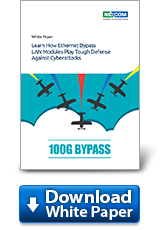Learn How Ethernet Bypass LAN Modules Play Tough Defense Against Cyberattacks

The era of fifth generation mobile networks (5G) has ushered in the adoption of technology such as Enhanced Mobile Broadband (eMBB), Ultra-Reliable and Low Latency Communication (URLLC), and Massive Machine Type Communications (mMTC) in network infrastructure. While everyone enjoys all the advantages that innovation brings, including high performance, high throughput, and high-quality communication, cybersecurity has become the foremost concern for 5G deployment. In light of this concern, NEXCOM introduces the NVIDIA® Mellanox® ConnectX®-5-based 100G Ethernet bypass LAN modules (Figure 1), NC 221FMS3 and NC 421FMS3, practical solution for 5G network security requirements.
Ethernet bypass is one of the key features of Ethernet network applications, especially for cybersecurity. The main purpose of the bypass feature is to block Ethernet traffic from entering the system or forward Ethernet traffic to another system when a system crashes or encounters a cyberattack. For example, as shown in Figure 2, Ethernet traffic from the Ethernet switch (Equipment 1) normally transfers data via CPU to the HPC server (Equipment 2) for Ethernet packet processing. When the HPC server crashes or encounters a cyberattack, with the 100G bypass LAN module (Figure 3) the HPC server can block Ethernet traffic to protect data or forward the Ethernet traffic to the other HPC server (Equipment 3) to maintain network functionality. Hence Ethernet performance and bypass control mechanisms are the two most critical aspects an Ethernet bypass needs. Luckily, through decades of experience, this happens to be NEXCOM’s expertise.
To read the white paper, please download the PDF.





















